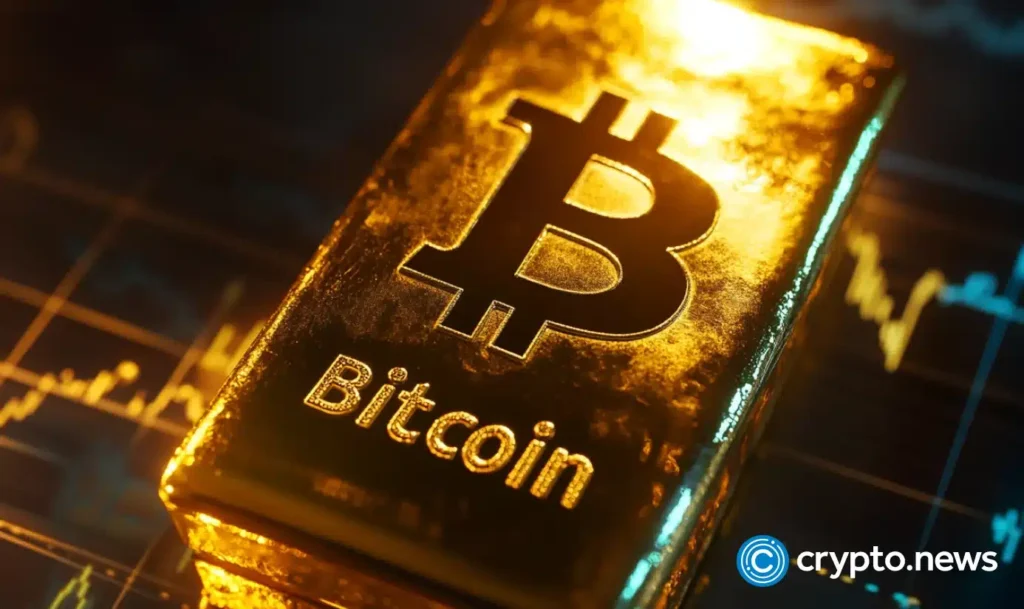Central banks have long relied on gold as a safe haven, but Bitcoin is starting to make its mark with prices near record highs. Analysts Marion Laboure and Camilla Siazon say the two could co-exist on balance sheets, each playing a role in diversifying reserves.
- Gold is hitting new highs, reaching $3,703 an ounce, while Bitcoin keeps climbing, trading close to its all-time high after surpassing $123,500 in August.
- Deutsche Bank analysts say the two could still “complement” each other on central bank balance sheets as alternative reserves.
- The analysts note that Bitcoin’s volatility is starting to cool, suggesting it could grow alongside gold without replacing it.
By 2025, both gold and Bitcoin (BTC) are showing remarkable strength, and according to Deutsche Bank research analysts Marion Laboure and Camilla Siazon, the two could even co-exist on central bank balance sheets by 2030.
In their Sept. 22 report titled “Bitcoin vs. Gold: The Future of Central Bank Reserves,” they examined how these very different assets are gaining attention as reserves amid global economic uncertainty.
Laboure and Siazon note that gold demand “remains strong in 2025, with prices reaching a new all-time high of $3,703 per ounce in September.” The analysts point to geopolitical uncertainty, ongoing central bank purchases, expectations of further Federal Reserve rate cuts, and questions over Fed independence as driving forces behind this surge. Gold’s long-standing reputation as a core reserve asset is also reinforced by these factors, they added.
At the same time, Bitcoin is making a case for itself as a potential reserve asset. The analysts highlight that the cryptocurrency has also demonstrated “remarkable resilience, trading close to its all-time high after surpassing $123,500 in August.”
More room to run
Bitcoin’s price strength reflects growing institutional adoption and signals its emergence as a potential hedge against macroeconomic risks, with Laboure and Siazon suggesting that the market still has “more room to run and will rise back up to $120,000 levels by the end of this year.”
This rise in Bitcoin coincides with a gradual shift in central bank reserves. The report notes that the dollar’s share of global reserves has been falling: from 60% in 2000 to 43% in 2024. Gold has long been the go-to alternative, but new developments in the U.S. are fueling debate over whether Bitcoin should also play a role.
“While gold has long been the standard alternative, the Trump Administration’s landmark decision to establish a U.S. Strategic Reserve this past March reignites the argument for central banks to hold Bitcoin as a reserve asset.”
Deutsche Bank
The analysts see a complementary relationship between the two assets as they note that Bitcoin and gold are deemed “complementary alternatives to traditional safe-haven reserves” due to their:
- low correlation with other asset classes;
- relatively scarce supply;
- use as a hedge against inflation and geopolitical volatility.
Gold may still maintain its lead in official reserves for now. However, Bitcoin is likely to grow in private and alternative reserve allocations, with the analysts also anticipating that the cryptocurrency’s notorious volatility could decline over time.
“Crucially, Bitcoin still lacks key components of a reserve asset: trust and transparency. However, as history has shown, during the early stages of its adoption gold was also prone to price sensitivity, and gold’s volatility has declined over time.”
Deutsche Bank
As Laboure and Siazon put it, Bitcoin’s volatility dropped to historic lows in August, with its 30-day volatility declining to 23% at a time that BTC’s price surpassed a record high above $123,500 on Aug. 15, suggesting a gradual decoupling between price and volatility.
Still, neither gold nor Bitcoin is likely to replace the dollar as the dominant reserve asset, the analysts note, adding that countries today “will also ensure that Bitcoin and other digital assets do not threaten the sovereignty of their currencies,” reflecting lessons learned from historical attempts to reduce reliance on gold.
Laboure and Siazon also draw a historical parallel. Like Bitcoin, gold was once “subject to skepticism, suspicion and demand speculation,” suggesting that Bitcoin’s journey will mirror gold’s path.
Key catalyst
The report emphasizes a broader, human-driven trend, noting that Bitcoin and other alternative assets will “likely continue to compete for our attention.” The analysts see the U.S.-led adoption of Bitcoin as a potential catalyst for transforming the cryptocurrency from a speculative investment into a recognized component of global finance.
In short, Deutsche Bank’s analysis suggests that gold and Bitcoin are likely to co-exist in central bank reserves by 2030, each playing its own role, though the report doesn’t specify what countries will be first to adopt this approach.
Gold remains the trusted benchmark, while Bitcoin’s surge reflects the growing appetite for digital alternatives. For central banks, the challenge will likely be balancing the old and the new, blending centuries-old traditions with emerging technologies.



